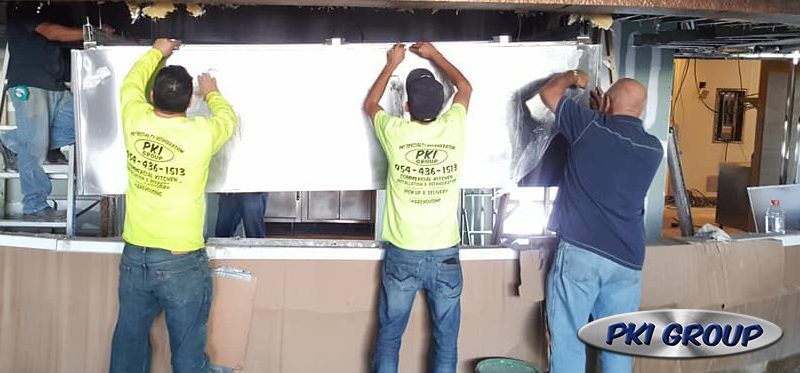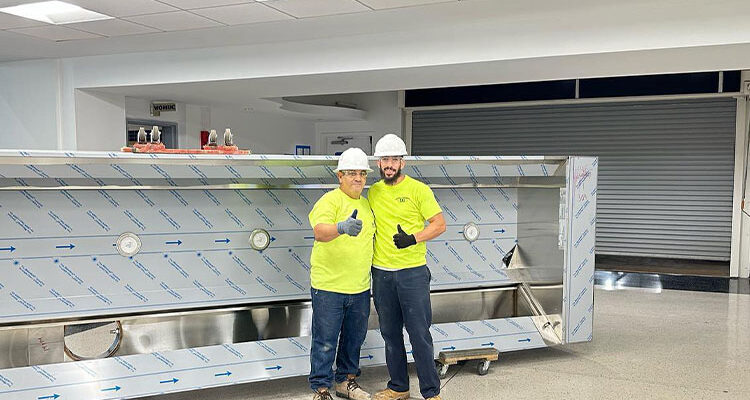Commercial Kitchen and Refrigeration Installers
Continue reading “The PKI Group Commercial Kitchen and Refrigeration Installers”
Please contact us today for a free consultation on your commercial project. For faster response call between business hours at 954-530-3757

Continue reading “The PKI Group Commercial Kitchen and Refrigeration Installers” →

In recent years, the importance of sustainability in commercial spaces has skyrocketed, with businesses across industries recognizing the need to minimize their environmental footprint. Among these, commercial kitchen installations stand out as crucial areas where sustainability practices can make a significant impact. From reducing energy consumption to minimizing waste, incorporating sustainable practices into commercial kitchen installations is not only beneficial for the environment but can also lead to long-term cost savings and enhanced brand reputation. Let’s explore some key sustainability practices that are transforming the landscape of commercial kitchen installations:
Energy-Efficient Equipment: One of the most impactful ways to promote sustainability in commercial kitchens is by investing in energy-efficient equipment. From refrigerators and ovens to dishwashers and ventilation systems, modern appliances offer a range of energy-saving features that can significantly reduce electricity consumption. Additionally, incorporating technologies such as heat recovery systems and programmable controls can further optimize energy usage, leading to lower utility bills and reduced carbon emissions.
Water Conservation: Water is a precious resource, particularly in commercial kitchens where it is used extensively for cooking, cleaning, and sanitation purposes. By implementing water-saving measures such as low-flow faucets, pre-rinse spray valves, and water-efficient dishwashers, businesses can minimize water wastage without compromising on hygiene standards. Moreover, regular maintenance and leak detection programs can help identify and address any water-related issues promptly, ensuring maximum efficiency and sustainability.
Sustainable Materials: When designing and outfitting commercial kitchens, choosing sustainable materials is essential to minimize environmental impact. From countertops and cabinetry to flooring and wall finishes, there is a wide array of eco-friendly options available, including recycled, reclaimed, and rapidly renewable materials. Additionally, selecting products certified by reputable sustainability organizations such as the Forest Stewardship Council (FSC) or Greenguard can help ensure that the materials used meet stringent environmental and health standards.
Waste Reduction and Recycling: The foodservice industry generates a significant amount of waste, much of which can be diverted from landfills through proper management practices. Commercial kitchen installations can incorporate waste reduction strategies such as composting organic waste, recycling packaging materials, and implementing food donation programs to minimize landfill disposal. Furthermore, designing kitchens with efficient waste separation and disposal systems can streamline the recycling process and promote a culture of sustainability among staff and patrons alike.
Green Building Certifications: For businesses committed to sustainability, pursuing green building certifications such as LEED (Leadership in Energy and Environmental Design) or Green Globes can provide formal recognition of their efforts. These certifications evaluate various aspects of a building’s design, construction, and operation, including energy efficiency, water conservation, indoor air quality, and material selection. By meeting the stringent criteria set forth by these programs, commercial kitchen installations can demonstrate their commitment to environmental stewardship and differentiate themselves in the marketplace.
The PKI Group
Sustainability practices play a vital role in shaping the future of commercial kitchen installations. By prioritizing energy efficiency, water conservation, sustainable materials, waste reduction, and green building certifications, businesses can create kitchens that are not only environmentally responsible but also economically viable and socially conscious. Through collective action and ongoing innovation, the foodservice industry can pave the way towards a greener, more sustainable future for generations to come. Call today for commercial kitchen installations at 954-530-3757

In the bustling world of commercial kitchens, where every square inch counts and productivity is paramount, the art of space optimization reigns supreme. From bustling restaurants to bustling catering services, the layout and design of a commercial kitchen can significantly impact workflow, efficiency, and ultimately, the bottom line. Today, we delve into the realm of space optimization in commercial kitchen installations, exploring innovative strategies and practical tips to maximize functionality without sacrificing form.
Understanding the Challenge:
Commercial kitchens often face unique challenges when it comes to space optimization. With a myriad of equipment, appliances, and workstations vying for real estate, it’s essential to strike the right balance between efficiency and ergonomics. From cramped quarters in food trucks to expansive layouts in hotel kitchens, each space presents its own set of opportunities and constraints.
Designing for Efficiency:
The key to unlocking efficiency lies in thoughtful design and meticulous planning. Here are some strategies to consider:
Streamlined Workflow: Analyze the kitchen’s workflow and design a layout that minimizes unnecessary movement. Keep essential tools and ingredients within arm’s reach to reduce time spent navigating the kitchen.
Modular Equipment: Invest in modular equipment and appliances that can adapt to changing needs and space constraints. Consider multifunctional units that can perform multiple tasks without occupying excess space.
Vertical Storage: Make use of vertical space by installing shelving units or hanging racks to store pots, pans, and utensils. Utilize overhead space for storage without cluttering countertops or floor space.
Flexible Workstations: Design flexible workstations that can accommodate different tasks and adapt to varying workloads. Incorporate movable tables or carts that can be rearranged to optimize workflow during peak hours.
Compact Appliances: Choose compact appliances and equipment without sacrificing performance. Look for slimline designs or stackable units that can maximize space efficiency without compromising functionality.
Case Studies in Efficiency:
Let’s take a look at two real-world examples of space optimization in commercial kitchen installations:
Food Truck Revolution: In the world of food trucks, space is at a premium. By strategically positioning equipment and embracing compact, multipurpose appliances, food truck operators can create efficient kitchen setups that deliver big flavors in tight quarters.
Hotel Kitchen Redesign: When a luxury hotel sought to upgrade its kitchen facilities, the focus was on efficiency without sacrificing elegance. By reimagining the layout, introducing modular workstations, and investing in state-of-the-art equipment, the hotel achieved a seamless blend of style and functionality.
The PKI Group
In the fast-paced world of commercial kitchens, space optimization is not just a luxury – it’s a necessity. By embracing innovative design principles, leveraging modular solutions, and prioritizing efficiency at every turn, kitchen installers can create spaces that not only meet the demands of today but also adapt to the challenges of tomorrow. So, whether you’re designing a bustling restaurant kitchen or a cozy cafe, remember: the key to success lies in unlocking the full potential of every square inch.
Efficient kitchens aren’t just efficient – they’re extraordinary. Call The PKI Group for commercial kitchen installations at 954-530-3757

Commercial kitchen fabrication can transform the effectiveness and pace at which your staff functions. Every restaurant owner knows the significance of choosing the right equipment and suitable surfaces such as stainless steel countertops for their commercial kitchens. That is why our fabrication specialists can install and improve any kitchen distribution by adding stainless steel pieces that would complement . Continue reading “Commercial Kitchen Installation and Fabrication Specialists” →
